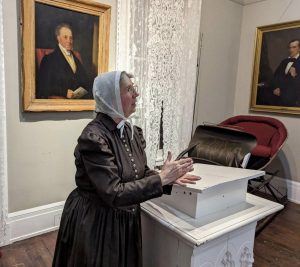 Compassion and courage. Those two words leap to my mind when I think about Mary J. Taylor. They’re the reason why I chose to speak as her at the Heritage Village Museum’s First Person Program Series on March 24.
Compassion and courage. Those two words leap to my mind when I think about Mary J. Taylor. They’re the reason why I chose to speak as her at the Heritage Village Museum’s First Person Program Series on March 24.
Mary and her parents left Virginia in 1814 when she was six years old. They likely took the same path as Mary’s grandfather Christopher Anthony, who traveled from Virginia a year earlier—crossing the Appalachians in a horse-drawn wagon and then taking a flatboat along the Kanawha and Ohio Rivers until finally arriving at the public landing in Cincinnati. Mary’s grandfather was a Quaker minister, and he was instrumental in encouraging Friends here to purchase their first meetinghouse on Fifth Street and in officially establishing Cincinnati Monthly Meeting in 1815.
Mary’s adult life was intertwined with her local Quaker community, its causes, and its dangers. Her brother-in-law, Achilles Pugh, printed The Philanthropist, the weekly newspaper of the Ohio Anti-Slavery Society. In 1836, Achilles’ printing house was vandalized by a pro-slavery mob that tore up the paper, poured out the ink, scattered the type, and dismantled the press. Nevertheless, the next day, Achilles returned to his printing shop, literally picked up the pieces, and continued printing The Philanthropist.
Mary had to face her own challenges as well. When she was 34 years old, her husband, Caleb W. Taylor, was killed while trying to help put out the massive fire at the pork processing house owned by her uncle. The death of her husband left Mary devastated, but not destitute. Between the income she received from Caleb’s share in a local dry goods store and the leases from properties they owned, she was able to focus on raising their four children and making sure they got the best education available.
All three of Mary’s daughters attended the Wesleyan Female College, and her son William studied medicine. He became the first pathologist at the Cincinnati Hospital, and later founded and served as the first president of the American Association of Obstetricians and Gynecologists.
After her children were grown, Mary focused on the needs of the poor, the neglected, the outcast, and the unprotected. She often visited the jail and convinced the city’s mayor to cover the patrol wagons that were used to transport women who had been arrested, sparing them public humiliation. In 1855, she helped establish the Home for the Friendless, which offered shelter and encouragement to prostitutes seeking a better life. During the Civil War, when Cincinnati’s hospitals were overflowing with the ill and injured, Mary tended to the soldiers who lay on the street, wiping their brows and offering to write letters to loved ones back home.
While the war was still raging, Mary’s daughter Hannah and two other Quaker women opened the Penn Mission Day School to provide day care and instruction to children whose mothers had to work while their fathers were off fighting and dying. The school also accepted pupils whose parents were too poor to afford the appropriate clothing and books required by the public schools.
Having seen so many little ones in jail with their imprisoned mothers for lack of a better option, Mary joined the board of Penn Mission to extend its work. Within ten days, the facility’s second floor had been converted into dormitories where children could stay. By December of 1864, The Children’s Home was officially incorporated. This institution—which provided both temporary care for children whose parents needed aid and permanent family placement for orphans—continued to exist until 2022, when it merged with St. Aloysius Orphanage to become Best Point Education & Behavioral Health.
Concerned about the adverse effects that men’s heavy drinking had on their wives and children, Mary became involved in the Temperance Movement and occasionally spoke at their meetings. She also joined other ladies in marching in the streets and entering saloons, where they would distribute religious tracts, sing hymns, and pray. The women were often met with profanity and scorn. Indeed, before they went into one tavern on Sixth Street, Mary asked the firemen in the engine house across the street for protection, should they need it.
By the time she was in her mid-sixties, Mary found that illness often prevented her from doing the work that the Spirit led her to do. Still, when she died in 1875, she left $200 to the Home for the Friendless and $500 to Cincinnati Friends Meeting for the benefit of the poor. In this way, she continued to give to others even after her time on this earth had passed.
To watch the 25-minute video of this presentation, click here.
